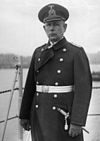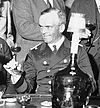
The Kriegsmarine was the navy of Nazi Germany from 1935 to 1945. It superseded the Imperial German Navy of the German Empire (1871–1918) and the inter-war Reichsmarine (1919–1935) of the Weimar Republic. The Kriegsmarine was one of three official branches, along with the Heer and the Luftwaffe of the Wehrmacht, the German armed forces from 1935 to 1945.

The Reichsmarine was the name of the German Navy during the Weimar Republic and first two years of Nazi Germany. It was the naval branch of the Reichswehr, existing from 1919 to 1935. In 1935, it became known as the Kriegsmarine, a branch of the Wehrmacht; a change implemented by Adolf Hitler. Many of the administrative and organizational tenets of the Reichsmarine were then carried over into the organization of the Kriegsmarine.

Erich Johann Albert Raeder was a German admiral who played a major role in the naval history of World War II. Raeder attained the highest possible naval rank, that of Grand Admiral, in 1939, becoming the first person to hold that rank since Henning von Holtzendorff. Raeder led the Kriegsmarine for the first half of the war; he resigned in January 1943 and was replaced by Karl Dönitz. At the Nuremberg Trials he was sentenced to life imprisonment but was released early owing to failing health.
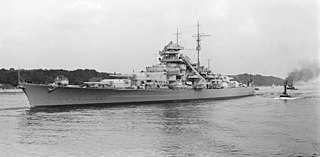
Bismarck was the first of two Bismarck-class battleships built for Nazi Germany's Kriegsmarine. Named after Chancellor Otto von Bismarck, the ship was laid down at the Blohm & Voss shipyard in Hamburg in July 1936 and launched in February 1939. Work was completed in August 1940, when she was commissioned into the German fleet. Bismarck and her sister ship Tirpitz were the largest battleships ever built by Germany, and two of the largest built by any European power.

Operation Rheinübung was the sortie into the Atlantic by the new German battleship Bismarck and heavy cruiser Prinz Eugen on 18–27 May 1941, during World War II. This operation to block Allied shipping to the United Kingdom culminated with the sinking of Bismarck.

Otto Ernst Lindemann was a German Kapitän zur See. He was the only commander of the battleship Bismarck during its eight months of service in World War II.
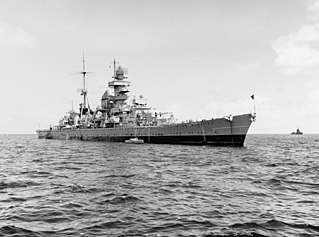
Prinz Eugen was an Admiral Hipper-class heavy cruiser, the third of a class of five vessels. She served with Nazi Germany's Kriegsmarine during World War II. The ship was laid down in April 1936, launched in August 1938, and entered service after the outbreak of war, in August 1940. She was named after Prince Eugene of Savoy, an 18th-century general in the service of Austria. She was armed with a main battery of eight 20.3 cm (8 in) guns and, although nominally under the 10,000-long-ton (10,160 t) limit set by the Anglo-German Naval Agreement, actually displaced over 16,000 long tons (16,257 t).

The Battle of the Denmark Strait was a naval engagement in the Second World War, which took place on 24 May 1941 between ships of the Royal Navy and the Kriegsmarine. The British battleship HMS Prince of Wales and the battlecruiser HMS Hood fought the German battleship Bismarck and the heavy cruiser Prinz Eugen, which were attempting to break out into the North Atlantic to attack Allied merchant shipping.

Sink the Bismarck! is a 1960 black-and-white CinemaScope British war film based on the 1959 book The Last Nine Days of the Bismarck by C. S. Forester. It stars Kenneth More and Dana Wynter and was directed by Lewis Gilbert. To date, it is the only film made that deals directly with the operations, chase and sinking of the battleship Bismarck by the Royal Navy during the Second World War. Although war films were common in the 1960s, Sink the Bismarck! was seen as something of an anomaly, with much of its time devoted to the "unsung back-room planners as much as on the combatants themselves". Its historical accuracy, in particular, met with much praise despite a number of inconsistencies.

Operation Berlin was a raid conducted by the two German Scharnhorst-class battleships against Allied shipping in the North Atlantic between 22 January and 22 March 1941. It was part of the Battle of the Atlantic during World War II. The ships sailed from Germany, operated across the North Atlantic, sank or captured 22 Allied merchant vessels, and finished their mission by docking in occupied France. The British military sought to locate and attack the German battleships, but failed to damage them.
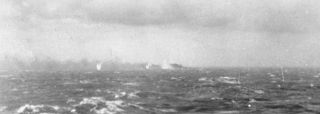
The last battle of the German battleship Bismarck took place in the Atlantic Ocean approximately 300 nautical miles west of Brest, France, on 26–27 May 1941 between the German battleship Bismarck and naval and air elements of the British Royal Navy. Although it was a decisive action between capital ships, it has no generally accepted name.

Adalbert Schneider was the First Gunnery Officer on board the battleship Bismarck, and was awarded the Knight's Cross of the Iron Cross for the sinking of HMS Hood on 24 May 1941 in the Battle of the Denmark Strait. Less than a week later, on 27 May 1941, Schneider and the majority of Bismarck's crew were killed in action during Bismarck's last battle.

Helmuth Brinkmann was a Vizeadmiral in the Kriegsmarine during World War II who captained the heavy cruiser Prinz Eugen. Prior to World War II he commanded the aviso Grille, Adolf Hitler's state yacht. He was also a recipient of the Knight's Cross of the Iron Cross of Nazi Germany. Brinkmann surrendered to British troops in 1945 and was held until 1947.

Otto Schniewind was a German General Admiral during World War II. He was a recipient of the Knight's Cross of the Iron Cross of Nazi Germany.

Johann Günther Lütjens was a German admiral whose military service spanned more than thirty years and two world wars. Lütjens is best known for his actions during World War II and his command of the battleship Bismarck during its foray into the Atlantic Ocean in 1941.

The organization of the Kriegsmarine refers to the operational and administrative structure of the German Navy from 1935 to 1945. Many of the organizational tenets of the Kriegsmarine were inherited from its predecessor the Reichsmarine. As World War II unfolded, the Kriegsmarine expanded to cover additional regions and responsibilities, most significant of which was the occupation of France and the Battle of the Atlantic.
Naval regions and districts were the official shore establishment of Nazi Germany's Kriegsmarine during World War II. The Kriegsmarine shore establishment was divided into four senior regional commands, who were in turn subordinated to the operational Navy Group commanders who commanded all sea and shore naval forces within a particular geographical region. Within each naval region were several subordinate naval districts who were responsible for all navy shore activities within their area of responsibility, most significantly were the various German ports of occupied Europe.
Flag officers of the Kriegsmarine were the leadership of the German Navy from 1935 to 1945. Most flag officers had also served as officers of the Reichsmarine, as well as the Imperial German Navy during World War I. German naval flag officers were divided into five Admiralty ranks while a senior captain rank, known as Kommodore also existed. The Kriegsmarine flag officers were responsible for holding the senior most naval positions within the organization of the Kriegsmarine.
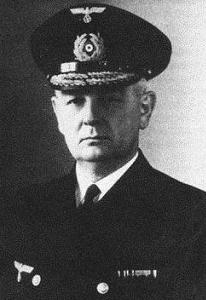
Leopold Siemens was a Vice admiral in the Kriegsmarine during World War II. He served as captain of the cruiser Karlsruhe in the mid 1930s and held the short lived position of Deputy fleet commander of the German Navy in 1941.
A type commander in the Kriegsmarine was a permanently assigned administrative officer in the organization of the Kriegsmarine which oversaw the development, deployment, and in some cases operational activities of the various classes of German naval vessels. Due to cross jurisdiction with the Navy group commanders, who tactically commanded all vessels at sea, some type commanders were little more than ceremonial officers who held a title with little authority. Others, such as Karl Dönitz who commanded the German U-boat force, exercised near total independence and held enormous authority, both operationally and administrative.


